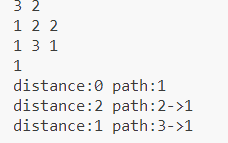图的最短路径
1.单源点最短路径
对于给定的有向图G=(V,E)和单源点
### Dijkstra算法 * 把图中的点分为两组
* 一组为已加入最短路径的点 * 一组为还为加入最短路径的点 *
将第二组中按距
hint:Dijkstra algorithm is similar to Prim algorithm.
here is the code 1
2
3
4
5
6
7
8
9
10
11
12
13
14
15
16
17
18
19
20
21
22
23
24
25
26
27
28
29
30
31
32
33
34
35
36
37
38
39
40
41
42
43
44
45
46
47
48
49
50
51
52
53
54
55
56
57
58
59
60#include<vector>
#include<iostream>
using namespace std;
//use adjacency matrix to memory the graph
const int INF = 0x3f3f3f3f; //to avoid overflow, this num can't be big
void dijkstra(vector<vector<int>> edges,vector<int>& distance,vector<int>& pre ,int n,int start){
bool visited[n+1]; // to mark which dot is in first group
for(int i = 1;i<=n;i++){
visited[i] = false;
distance[i] = INF;
pre[i] = -1;
}
distance[start] = 0;
for(int i = 1;i<=n;i++){
int index = -1;
int min = INT_MAX;
for(int j = 1;j<=n;j++){ // to find the dot whose distance between first group is minimal
if(!visited[j] && distance[j]<min){
min = distance[j];
index = j;
}
}
if(index == -1){
break;
}
visited[index] = true;
for(int j = 1;j<=n;j++){ //update the remaining dot's distance between first group
if(!visited[j] && distance[index]+edges[index][j] < distance[j]){
distance[j] = distance[index]+edges[index][j];
pre[j] = index;
}
}
}
}
int main(){
int n,m;
cin>>n>>m;
vector<vector<int>> edges(n+1,vector<int>(n+1,INF));
vector<int> distance(n+1,INF);
vector<int> pre(n+1,-1);
for(int i = 0;i<m;i++){
int x,y,w;
cin>>x>>y>>w;
edges[x][y]=w;
}
int start;
cin>>start;
dijkstra(edges,distance,pre,n,start);
for(int i = 1;i<=n;i++){
cout<<"distance:"<<distance[i]<<" ";
cout<<"path:"<<i;
int head = i;
while(pre[head] != -1){
cout<<"->"<<pre[head];
head = pre[head];
}
cout<<endl;
}
return 0;
}

## 每一对顶点间最短路径
For any given directed graph G=(V,E),find out the shortest path of any
pair of vertexs.
There are also other algorithms like Floyd algorithm which is similar to
Dijkstra algorithm. Here omit details.